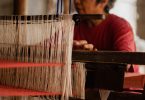Traditional tattoos, known as batok, have been a part of Filipino culture for centuries. They served as a way to signify accomplishments, social status, and beauty. Men traditionally received tattoos for feats in battle, while women’s tattoos indicated strength and connection to male relatives who were warriors. Designs often included geometric shapes, animals, plants, or representations of humans. Some ethnic groups also included lightning, mountains, water, stars, and the sun.
The exact origins of batok are unknown, but they are believed to date back to pre-colonial times. Each ethnic group in the Philippines had specific terms and designs for their tattoos. These tattoos served as symbols of tribal identity, kinship, bravery, beauty, and social or wealth status. The process of tattooing was also considered a sacred ritual among some groups.
Traditional tattoos were applied using a hafted needle and ink made from soot or ashes. The needle was tapped with a length of wood to drive the ink into the skin . Tattooing was a painful and lengthy process.
Spanish colonization led to the decline of tattooing in many areas of the Philippines. However, the tradition is still practiced by some indigenous groups in the Philippines today . There is also a revival of interest in traditional tattoos among Filipinos in general. This revival has led to the development of a contemporary Filipino tattoo style that incorporates traditional designs with modern techniques.
Overall, traditional tattoos are a significant part of Filipino culture. They serve as a way to connect to the past and celebrate Filipino heritage.
Video
Additional Information
Read more about the Philippine Culture and Traditions. Check out the link below to discover more!







